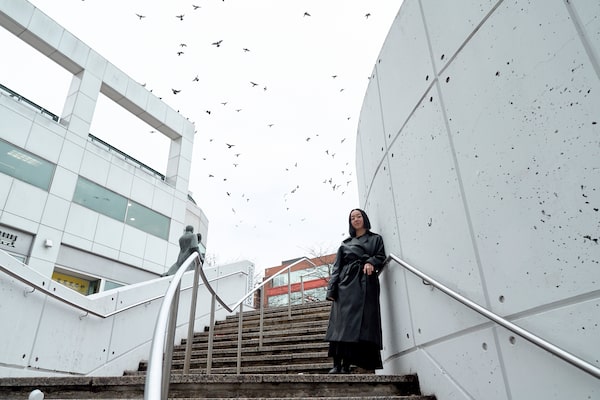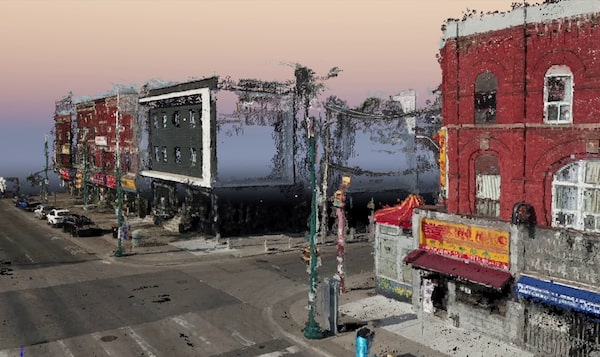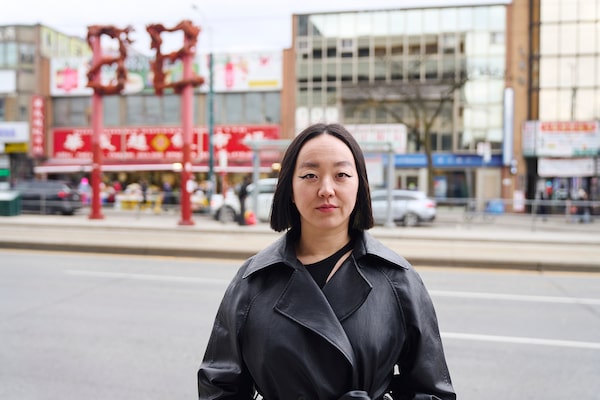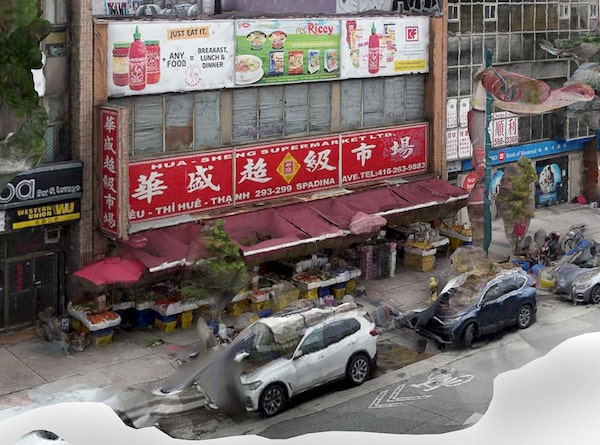
Architect Linda Zhang is using technology to bring Torontonians into the architectural design process for protecting the city’s Chinatown. 'If they actually listened,' she says of the city, 'we can do it.'May Truong
Growing up in Southwestern Ontario, between Kitchener, Windsor and London, architect Linda Zhang developed an affinity for Toronto’s Chinatown at a young age.
“I spent my childhood driving several hours with my family to do weekly groceries in Toronto’s Chinatown,” she recalls.
It would be years before she’d return. After studying architecture at McGill and Harvard universities, Ms. Zhang worked as an architect in Germany, then taught at Syracuse University in New York before returning to Toronto in 2018 for a role at Toronto Metropolitan University’s (TMU) school of interior design. The move brought her back in close proximity to the Chinatown she grew up visiting, stoking her interest in the neighbourhood yet again.
It was here that she began applying her architecture skill set to her affinity for Toronto’s Chinatown, one of many Chinatowns across Canada that’s faced repeated displacement. Using new technologies such as virtual reality, 3-D printing and drones, Ms. Zhang has spent years creating real and virtual models of Chinatown – work that, amid continuing gentrification, she calls an act of resistance.
“I’ve always looked at the memories and stories of the place I’ve lived and worked,” Ms. Zhang explains. “I feel, to some degree, a bit of responsibility to be involved in shaping and organizing and supporting the things that you benefit from being a settler on.”
City Space podcast: Can Chinatown, Vancouver, survive the neighbourhood’s revitalization?
Around the time Ms. Zhang moved back to Toronto, high-profile real estate developments were slated to oust long-standing institutions in Chinatown – notably, restaurants Rol San and Bright Pearl, which would be replaced by condo buildings. “I arrived at a time when a lot of rapid displacement was happening,” Ms. Zhang recalls.
Diving into Toronto’s city archives, she learned more about the erasure experienced by an early Chinese settlement near Union Station, which the Great Fire of Toronto destroyed in 1904. Chinese Torontonians then moved west to a neighbourhood called The Ward, only to be displaced again by the construction of city hall to its current location around the intersection of Dundas and Spadina. Ms. Zhang was dismayed to find a lack of information about the architecture of Chinatowns both past and present. So, she began to consider how she could use her expertise to help the Chinatown of today.
Her new position as an assistant professor at TMU gave her access to a host of modern technologies, such as drones (Ms. Zhang has a licence to fly them) and 3-D scanning software, which is most commonly used by real estate agents and developers. So, in the summer of 2018, Ms. Zhang started capturing drone photographs of all the buildings and storefronts in Chinatown, from which she created a 3-D reconstruction of the neighbourhood.
“It was like taking a record and addressing a void that there was in the archives,” she says.
Ms. Zhang then thought about how she could make her digital records accessible to Chinatown’s community members. So, she launched a virtual board game, which tasks two players with building their own Chinatown from 3-D scans, asking them to discuss which buildings they want to include and why.

Using technologies such as virtual reality, 3-D printing and drones, Zhang has spent years creating real and virtual models of Chinatown.Linda Zhang
“I had conceived the project as a data collection method,” Ms. Zhang says. “I intended to do an architectural analysis of what heritage people cared about.” The conversations between the two players ended up being more interesting to Ms. Zhang, as participants discussed how they envisioned what Chinatown could look like in the future.
Shortly afterward, the pandemic hit and Ms. Zhang participated in a speculative fiction writing workshop for youth. “We came together and imagined a different possible future for us and for Chinatown in 30 years,” she says. That experience resulted in an anthology of nine stories that Ms. Zhang edited into a book, Reimagining ChinaTOwn, published by Mawenzi House last May.
While Ms. Zhang’s work began as a way to keep record of Chinatowns of the past and present, it has since evolved into facilitating visions of Chinatown into the future.
“[Ms. Zhang]’s work is so powerful both for reflecting the diversity of a community and for building it and making it stronger,” says Larissa Lai, an author and professor teaching classes in Asian Canadian studies at the University of Toronto, where she assigns Reimagining ChinaTOwn to her students.
“Good art projects help preserve Chinatowns by putting the spotlight on them and showing why they matter,” she says. “Really great art projects offer ideas and methods for the work not just of preservation but of growth and change.”
Ms. Zhang put these principles to practice yet again in 2021. After receiving a $250,000 grant from the Government of Canada’s New Frontiers in Research Fund, Ms. Zhang ran a project called Planting Imagination, in which she engaged community members to co-design and create a new design for the back garden of Cecil Community Centre in Toronto’s Chinatown. The process started with setting values, such as inclusivity and sustainability. Then, the group designed the garden with areas for growing plants, for playing and for hosting events, complete with an outdoor auditorium.

'I’ve always looked at the memories and stories of the place I’ve lived and worked,' Zhang says.May Truong
Ms. Zhang made the design process accessible to all the participants – even seniors – regardless of their backgrounds. “For a long time, you would need so much skill to sketch something in 3-D and draft it,” she explains. “We were able to make a web browser-based platform where anyone could design and use very intuitive buttons.” Using virtual reality, in which users engage with virtually generated 3-D images, participants could see their designs in 360 degrees. With augmented reality, in which computer-generated images are superimposed upon reality, they walked around with iPads in the garden space to see what their ideas would look like at scale. Both tools brought in members who might otherwise be left out.
“I am able to look at a plan and see in my mind what that would look and feel like because I’ve had the spatial training,” Ms. Zhang explains. “But for someone who’s not an architect, that’s difficult. AR gives you access to that.”
Jessica Chen, city planner and co-founder of the JIA Foundation, an organization that protects and promotes the cultural heritage of Montreal’s Chinatown, commends the idea. “It’s very exciting to look at what Linda is doing,” Ms. Chen explains. She praises the notion of democratizing access to data and the ability to imagine what communities can look like. “Visualization is a very powerful tool,” Ms. Chen says.

Linda Zhang
However, Ms. Chen hopes, like any community feedback process, that those who are gathering ideas and data from the community make good use of it. “People can get disillusioned if their dreams don’t go anywhere,” she says.
Ms. Zhang hopes that Planting Imagination will serve as a pilot of sorts, to show that planning a neighbourhood can be something that’s meaningfully done in tandem with community members – bringing dreams to reality. “Technology has advanced so far that we, as architects, can act more like facilitators,” Ms. Zhang explains. “We can bring folks together and come to a collective decision. We could make a vision together and build it.”
Her dream is to see the visions of Chinatown’s community members one day realized. “If it’s possible to do on this pilot site, then it’s possible to do at the scale of a neighbourhood and a new development,” she explains. “It’s possible to then tell the city they need to do better.
“Because, if they actually listened and made us a part of the process for design,” she says, resolutely, “we can do it.”